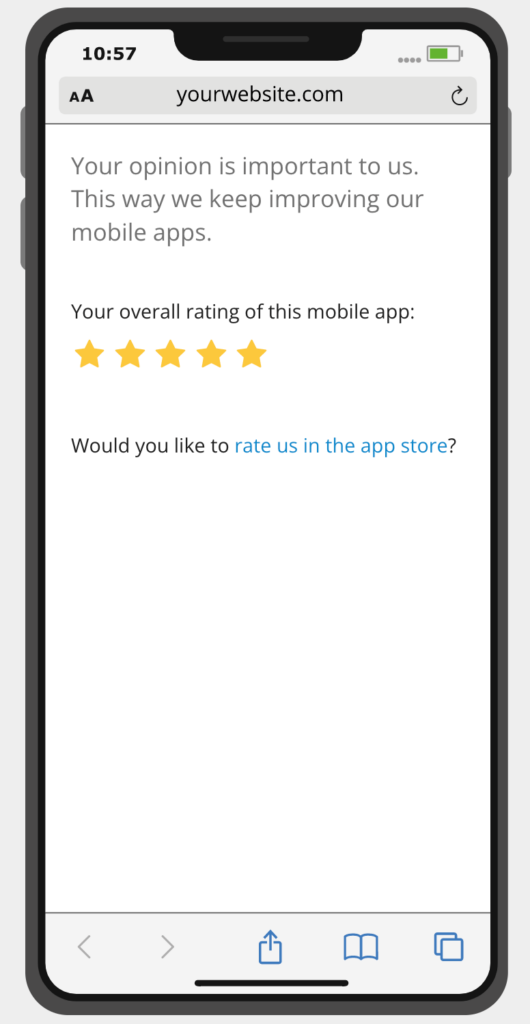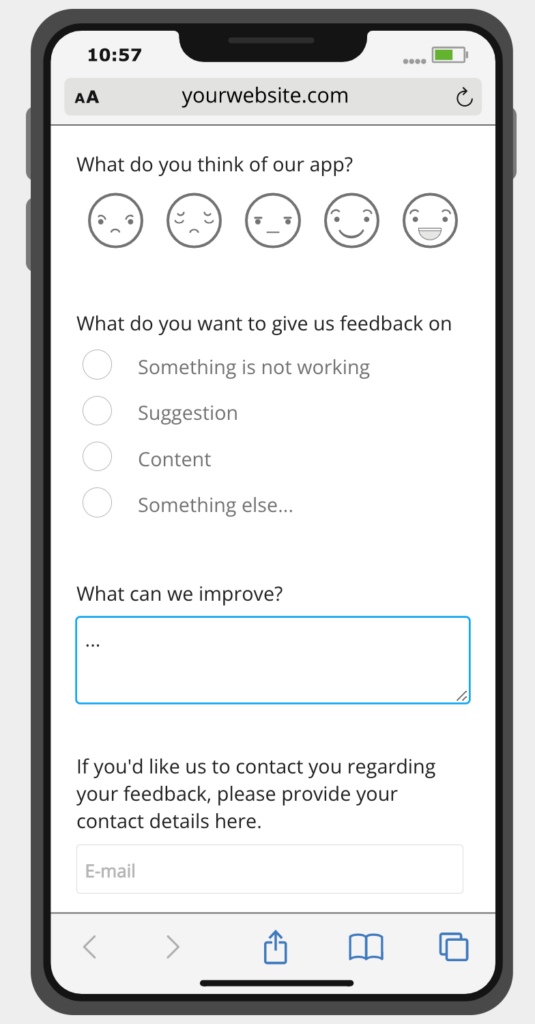App and smartphone usage has been growing at a steady rate for the last few years. And with over 6.5 billion smartphone users in the world, it is obvious that more companies are developing apps, and incorporating them into their business. The average smartphone user has up to 80 mobile apps on their phone and uses 9 apps on a daily basis. If you are a mobile marketeer, there’s a big chance you have heard of in-app surveys. If you are not familiar with the term yet, grab a cup of coffee and keep reading.
In this guide, we will look at four simple in-app survey templates, all of which will help you effectively collect in-app feedback. But first, it is important to understand what in-app surveys are.
What are in-app surveys?
In-app surveys are an amazing way to connect with your customers, and therefore a crucial tool for collecting user feedback. These surveys are deployed into apps, enabling you to gather relevant feedback on how your customers view your app as a whole, or how they view the individual features. These surveys also provide tons of other helpful insights from your online users, which help you create and improve the overall customer experience.
For instance, think about the times you have ordered food via Uber Eats, or when you bought shoes on Zalando. Normally, when you are browsing on the app, or after the purchase, a small survey pops up with various questions like “How was your experience”? Or “How would you rate this feature”? These are in-app surveys.

The importance of in-app surveys
The number one challenge marketers face regarding collecting customer feedback is receiving a response from their users. According to Instabug, response rates can be as low as 1-3% for mobile web surveys. But do not worry, there is good news: in-app surveys appear to be much more effective. That is because they do not disturb the mobile UX. In other words, these surveys are uniquely designed for the app, which makes a huge difference in usability. For instance, Mopinion for Apps allows “advanced triggering”, which means that feedback forms will pop up and can be triggered based on certain in-app events.
Some other benefits that make in-app surveys great:
- Data only tells you so much. By getting actual responses, you get to know the why behind the data.
- You can identify pain points of your customers and think of ways to improve your app
- Get insights into the overall user experience
- Gather data regarding specific app features and improve up
- Let your visitor know that their opinion matters
- Optimize user retention by finding out who your unsatisfied customers are
Points of caution when building in-app surveys
Many app users share the same frustration when it comes to in-app surveys. Imagine you are hungry and trying to order food after a long workday. But then, suddenly, the app interrupts you with a survey pop-up that you must fill in to complete your order.
This situation is tough for mobile marketers because most people do not like to be interrupted too early in the buying process. That is why it is important to keep the amount of interruptions as minimal as possible.
Additionally, it is important not to make the questions too difficult. That means only asking the visitor what is actually necessary. Do not ask them long and confusing questions, ask them one thing at a time. To achieve this, think beforehand about what kind of feedback metrics are needed to create the perfect mobile app survey questions.
Furthermore, it is crucial to make sure that answering the questions within your survey sounds appealing: “Your feedback matters to us” Give the visitor a reason to participate and amplify the importance of their feedback. Motivation is very important for app users when it comes to responding to a survey. Incentives such as winning a prize are often used by companies: “Give us your opinion in this survey and get the chance to win a free iPad!”
Lastly, you should also aim to create effortless input fields, as people generally like rating with big smiley faces rather than with numeric input fields.

Now that you have a general idea behind in-app surveys, the next step is deciding on a tool to collect the in-app feedback. With Mopinion for Apps, powerful user feedback can be collected from your native apps with easy to install SDKs for Android and iOS. How useful this data turns out to be, is completely dependent on the content of the survey.
Therefore, we have laid out four simple in-app survey templates to get you started.
1. Product rating
When a customer has been using the app for a longer period of time, there is a big chance they have an opinion regarding the app’s functionalities. To find out if these opinions are positive or negative, and how to improve the overall user experience, you can use questions such as “How would you rate this product?” or “Are you satisfied with how the app works?’. These questions are meant to assess the app, product, or service in general.

You could implement a Net Promoter Score (NPS), Customer Satisfaction (CSAT), or Star/Smiley rating system.
2. What can be improved?
Improving your app should be a priority, but this kind of question is also crucial for the improvement of individual features.

Often you’ll see this template, which incorporates an open question or multiple choice question.
3. Post-purchase behavior
This kind of in-app survey is key to learning more about the customer’s emotions and sentiments after they have completed the purchasing process. Asking customers about their level of satisfaction right after the purchase has been made will provide insight into their experience and help you identify pain points early on. Frequently asked questions include, for example, “‘How fast was the delivery?” and “Was it easy to book your flight?”.

4. Goal Completion
The goal completion metric is focused on what task the visitor wants to complete, and if the task has been completed successfully. Using this metric, you can also find out what your app is being used for and if there were hurdles whilst trying to achieve the goal.

Try Mopinion for Apps now
Are you still looking for an easy-to-use, and flexible mobile app feedback tool? And do you want to recreate the four in-app survey templates we provided that will help you improve the user experience? Then do not hesitate and try Mopinion for Apps!
We hope this guide was helpful and has given you some inspiration to start making your own in-app surveys. Once you’ve gotten started, the data will give you a great deal of valuable insights into the purchasing process and your customer’s experience.
Ready to see Mopinion in action?
Want to learn more about Mopinion’s all-in-1 user feedback platform? Don’t be shy and take our software for a spin! Do you prefer it a bit more personal? Just book a demo. One of our feedback pro’s will guide you through the software and answer any questions you may have.








